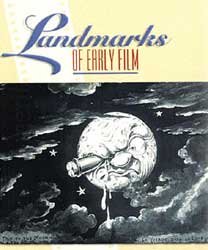 Of the two-disc set The Magic of Melies (1997), disc two has fourteen short films by George Melies, which follow the documentary George Melies: Cinema Magician (1978) directed by Patrick Montgomery & Luciano Martinengo.
Of the two-disc set The Magic of Melies (1997), disc two has fourteen short films by George Melies, which follow the documentary George Melies: Cinema Magician (1978) directed by Patrick Montgomery & Luciano Martinengo.
This documentary can also be had on Landmarks of Early Film Volume Two: Magic Melies (1997) which is really just the second volume of George Melies: Cinema Magician in a different package.
It can additionally be found included as part of the five-disc dvd set The Movies Begin: A Treasury of Early Cinema 1894-1913 (1994), despite that volume one of Landmarks does not the other disc in the Magic of Melies set.
The films on Disc 2 are: Impossible Voyage, Untamable Whiskers, The Cook in Trouble, TchIn-Chao the Chinese Conjurer, The Wonderful Living Fan, The Mermaid, The Living Playing Cards, The Black Imp, The Enchanted Sedan-Chair, The Scheming Gamblers' Paradise, The Hilarious Posters, The Mysterious Retort, Good Glue Sticks & Long Distance Wireless Photography.
The documentary is a mite lackluster & the strong parts are the excerpts from Melies films, unlabeled however so if you see a clip from one you don't recognize, you might never know which it was. It would of course are better seen separately in their entirety, & not all the fragments are from the complete films provided afterward.
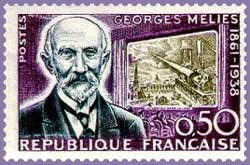 Clocking in at only twenty-one minutes, even that short length is heavily padded with excerpts from Melies films. There's a monotone feeling to the structure, & a falsity to the way the narrator/actor pretends to be Melies while reading a script that is rarely constructed of anything Melies actually said. Clocking in at only twenty-one minutes, even that short length is heavily padded with excerpts from Melies films. There's a monotone feeling to the structure, & a falsity to the way the narrator/actor pretends to be Melies while reading a script that is rarely constructed of anything Melies actually said.
Still, the days of pioneer filmmaking are inherently so interesting that Cinema Magician ends up being informative & worthwhile, capturing some sense of the man's sweetness, confirmed by the innocent charm of his films.
"For me, cinema is the fountain of youth," says Melies or his impersonator, & indeed Melies regarded his work lightly as play. We glimpse some of his youthful artwork & political cartoons & are given small hints of his childhood family life & schooling. He went to London for 1884-1885 to study, but ended up spending hours that should've been devoted to study at a London theater that specialized in magic, The Egyptian Hall.
When he returned to Paris, he needed to escape being part of his father's successful shoemaking business. He was funded by his family to purchase the Robert Houdin Theatre which presented a great many magic acts, with magic lantern vignettes projected between acts. It was 1895 & he was twenty-six years old.
He saw Auguste Lumiere's first motion picture projector in 1895, & the direction of his life changed at once. Edison's nickelodian devices required each individual to stand on a stool & gaze downward into a box to see moving pictures. It was a wonder, sure, but no theatrical event would ever be possible unless these moving pictures could be gotten out of the box. Lumiere had solved the problem.
But he refused to sell one of his machines to Melies. The documentary alleges this was because Auguste believed it would be wrong to take money for a device to be used for entertainment that could at best be only a passing fad, & the real purpose of his equipment was scientific enquiry. This however isn't quite inaccurate.
Although Auguste's excuse to Melies was that he wanted it used only for scientific & medical purposes, in reality he & his brother hoped to profit by the device personally, & their business-minded father didn't want projectors sold to others who'd become competition.
Here again the documentary slips up a little in implying Melies was therefore forced to design his own equipment. The synoptic nature of the twenty-minute documentary leaves the impression that he made everything himself.
In reality projectors were being independently invented of the Lumieres. Melies purchased a different projection device from a London inventor, & not long after obtained a great projector from a French inventor. He did improvise a bit of reverse technology on his first projector to turn it into a camera, in order to make films, his first being A Card Game (Une Paritic de cartes, 1896) shot in his family's garden.
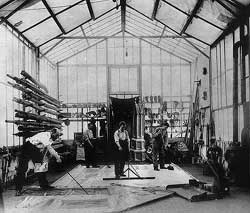 Eventually he set up a large production studio to make the short-short films. It was a glass-roofed warehouse that enforced a schedule for filming in the late morning & early afternoon before the stage was in shadow. Eventually he set up a large production studio to make the short-short films. It was a glass-roofed warehouse that enforced a schedule for filming in the late morning & early afternoon before the stage was in shadow.
Soon he would be hiring actors & dancers from the Parisian stages, caberets, & opera houses to create increasingly elaborate films. Initially exhibited in carnivals & fairgrounds, it was a while before he had his own projector for exhibitions at his Robert Houdin Theatre.
The public's insatiable apetite for moving pictures spread worldwide, & specialty theaters arose in great numbers. Melies would even open offices in New York City, & send his brother to run that office, in order to cash in on the American obsession. His tiny operation was highly profitable at a time when every new filmmaking studio was just another individual artist or inventor plugging into brand new public tastes.
But the business environment was rapidly changing even as was the technology. The documentary fails to narrate well the height of Melies' career, jumping as it does to his second marriage in 1925. I cannot resist filling in that blank:
He remained the top filmmaker in the world until about 1907 when Pathe & Gaumont, run as business enterprises rather than by a craftsman, began pushing him from the marketplace. The Edison company in America was even more cutthroat. Edison pirated A Trip to the Moon (La Voyage dans la lune, 1902) which was bound to have been Melies' top money-earner in North America, & it was just not possible to go head-to-head in court with the powerful Edison, a vicious man whose mastery of business propoganda rendered him a superhero throughout his country.
Melies' brother made a devil's alliance with Edision which required him to provide the Edision Manufacturing Company with great numbers of Star Films product on a weekly basis. If Melias had been capable of pumping out product that quickly things might've gone well, but he invested in a second studio & a harried production schedule impossible to maintain, & the Edison alliance became an additional debt load.
Melies' first bankruptcy was in 1913, & he would never make another film, though he kept the studio for some years so must have intended to return to his art eventually. Then in 1914, due to war, the Robert Houdin Theatre had to close its doors.
He hung on to his inactive studio until 1923 when everything was tragically liquidated. His paper negatives for all his films had no buyer, & Melies had no way of storing so much material, so he burned them -- only later realizing what a horrifying blunder that had been. None of this is mentioned in the short documentary, nor that his finished film footage had been confiscated during the first world war, to be melted down & turned into the soles of soldiers' boots.
Skipping quickly over the loss of his first wife, his theater, his studio, & his fortune, & not even mentioning how much of his work was so soon destroyed, the documentary informs us he found solace in the arms of a woman he'd known since youth, actress Jehanne D'alcy who had been the world's first super-starlet thanks to Melies' films.
D'Alcy was by this time poor like Melies himself. She ran a toyshop in Paris & when she married Melies in 1925, they thereafter ran the shop together. They never made much money, but it was a happy life. Here again the documentary gives a wrong impression, of a man sitting in a poor shop selling children's gimcrack. In reality he was heavily involved in staging operettas that starred his entire family & remained very creative during this period.
He probably would have preferred to have kept making films, but between the wars it had become such a tough-guys business-world, with no place for a man who approached it as a cottage industry for the sake of art.
Such is the rough outline of Melies' life. Anyone who knows even a little about the man will learn nothing new in Cinema Magician & will find themselves like I did filling in massively important details the documentary neglected. But as a quick introduction to the man behind Star Films, it's adequate. There is, however, a longer documentary on the first disc, & that one greatly makes up for the short one's limitations.
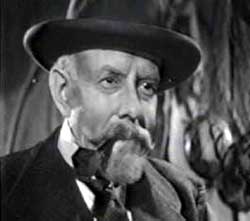 Disc One of the The Magic of Melies set includes Jacques Meny's vastly more substantive documentary, plus fifteen Melies films. These are the landmark A Trip to the Moon, plus the following:
Disc One of the The Magic of Melies set includes Jacques Meny's vastly more substantive documentary, plus fifteen Melies films. These are the landmark A Trip to the Moon, plus the following:
The Four Troublesome Heads, The Infernal Cakewalk, The Scheming Gamblers' Paradise, The Mkusic Lover, The Infernal Boiling Pot, The Man with the Rubber Head, The Living playing Cards, Humorous Posters, The Devilish Tenant, Imperceptible Transmutations (this is the only place I've noticed Chao-Chu: The Chinese Conjuror with this title attached), Bluebeard, Fat & Lean Wrestling Match, & One-Man Band.
Meny's 1997 documentary includes fake narration of Melies himself, but unlike the Melies narrator of the 1973 documentary, he's not the primary narrator in this one, & what is played as from Melies' voice is not fabricated. Having been made cheaply for French television, it's surprising how well done this is.
It's one weakness is for the "reenactment" docudrama moments that are sometimes an embarrassment, though recreating how Magic Lantern Shows Melies put on at the Robert Houdin Theatre is most illuminating & fun, conveying how comfortable Melies was with projected light-&-shadow entertainment even before motion picture films began.
I liked best the information about how the Robert Houdin Theatre was run, with magicians the major acts. It speaks a lot for the content of his films to come. He loved magic, & had first attended this theater when he was ten years old, & was delighted to have been its manager & director for its last thirty years.
Years later, in despair & desparation, he was to destroy negatives for all his films, "not realizing I was making an irretrievable mistake." But he was much more careful with Robert Houdin's material. He built on Houdin's secrets & designed new magic acts for the theater.
And he took meticulous care of Houdin's automata which came with the theater, maintaining them carefully, & when the theater was finally lost, he made sure the automata were preserved for posterity, & happily they exist to this day, a few shown operating for this dicomentary. Strictly as an aside, one of Melies lost films was The Clown & the Automaton (Gugeusse et l'automate, 1897) undoubtedly influenced by the automata at his theater.
When he had his first film studio built in the 1890s, it was in general shape a copy of the Robert Houdin Theatre, though glass-roofed & with very different specific requirements. This emulation of shape indicates just how much he loved that theater, & how painful it must have been when at last it closed forever.
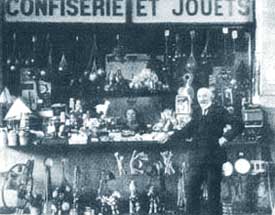 Another thrilling part of the film (thrilling for whoever adores Melies) is about his later life when he worked in the toyshop. Here he was accessible to the public, & a new generation of filmmakers found him, starting with film magazine editor Leon Druhot. Another thrilling part of the film (thrilling for whoever adores Melies) is about his later life when he worked in the toyshop. Here he was accessible to the public, & a new generation of filmmakers found him, starting with film magazine editor Leon Druhot.
By 1929 he would be widely "rediscovered" & regained full recognition, having a art exhibition of his work with a revival of some of his films found in private hands.
Two thousand attended opening night, & I won't describe how it was Melies came to be standing center stage for an impromptu speech, as it's the one "reenactment" moment of the documentary that was really worthwhile & exciting.
He was awarded the French Legion of Honor in 1931 & the revival of interest in his work lasted until 1933. when Melies faded again into the background. The documentary has already ended at this point, eager for an upbeat close.
Had it continued to the end of his life, it could've been a mite sad, as he was forced to sell whatever remained of his film footage by the boxful to junk shops just to have a bit of pocket money. At this time old film footage was treated like "used books" & "used sheet music" & got stockpiled in antique stores & by used book dealers to resell slowly or never, so they never paid much for a boxful of film.
Early in 1938 at the age of seventy-six, after a long illness, he died of cancer in the Hospital Leopold-Bellin in Paris. His grave is in the Pere Lachaise cemetary.
copyright © by Paghat the Ratgirl
|
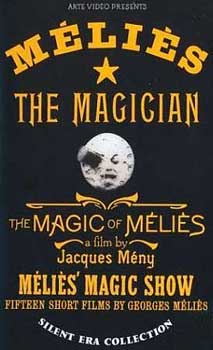

 Clocking in at only twenty-one minutes, even that short length is heavily padded with excerpts from Melies films. There's a monotone feeling to the structure, & a falsity to the way the narrator/actor pretends to be Melies while reading a script that is rarely constructed of anything Melies actually said.
Clocking in at only twenty-one minutes, even that short length is heavily padded with excerpts from Melies films. There's a monotone feeling to the structure, & a falsity to the way the narrator/actor pretends to be Melies while reading a script that is rarely constructed of anything Melies actually said. Eventually he set up a large production studio to make the short-short films. It was a glass-roofed warehouse that enforced a schedule for filming in the late morning & early afternoon before the stage was in shadow.
Eventually he set up a large production studio to make the short-short films. It was a glass-roofed warehouse that enforced a schedule for filming in the late morning & early afternoon before the stage was in shadow.
 Another thrilling part of the film (thrilling for whoever adores Melies) is about his later life when he worked in the toyshop. Here he was accessible to the public, & a new generation of filmmakers found him, starting with film magazine editor Leon Druhot.
Another thrilling part of the film (thrilling for whoever adores Melies) is about his later life when he worked in the toyshop. Here he was accessible to the public, & a new generation of filmmakers found him, starting with film magazine editor Leon Druhot.